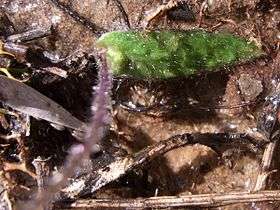Glossodia minor
| Small Waxlip Orchid | |
|---|---|
 | |
| Ku-ring-gai Chase National Park, Australia | |
| Scientific classification | |
| Kingdom: | Plantae |
| (unranked): | Angiosperms |
| (unranked): | Monocots |
| Order: | Asparagales |
| Family: | Orchidaceae |
| Subfamily: | Orchidoideae |
| Tribe: | Diurideae |
| Subtribe: | Caladeniinae |
| Genus: | Glossodia |
| Species: | G. minor |
| Binomial name | |
| Glossodia minor R.Br. | |
Glossodia minor, the Small Waxlip Orchid is a small terrestrial orchid, found in eastern Australia. Usually found near the coast, often in heathland growing on sandstone based soils. It may grow from 5 to 16 cm (2 to 6.5 in) tall. One or two flowers appear in winter or spring. They are rarely white, but more often a pink, violet, rosy pink or bluish purple. The single leaf is parallel to the ground, 2 to 4 cm (1 to 1.5 in) long, and broad lanceolate in shape. The leaf and stem are noticeably hairy.[1] This plant first appeared in scientific literature in 1810, in the Prodromus Florae Novae Hollandiae authored by the prolific Scottish botanist, Robert Brown.[2]
Glossodia minor can be distinguished from the waxlip orchid (Glossodia major) by its smaller flowers. The latter species has a white base to the labellum.[3]
Glossodia minor is found along the eastern coastline of Australia in Queensland and New South Wales, where it reaches as far west as Temora.[4] It is also found in Victoria west to Marlo.[3]

References
- ↑ Les Robinson - Field Guide to the Native Plants of Sydney, ISBN 978-0-7318-1211-0 page 250
- ↑ "Glossodia minor R.Br.". Australian Plant Name Index (APNI), IBIS database. Centre for Plant Biodiversity Research, Australian Government.
- 1 2 Bishop, Anthony (2000). Field guide to the orchids of New South Wales and Victoria. UNSW Press. p. 163. ISBN 0-86840-706-2.
- ↑ P. Bernhardt. "New South Wales Flora Online: Glossodia minor". Royal Botanic Gardens & Domain Trust, Sydney, Australia.
External links
| Wikimedia Commons has media related to Glossodia minor. |
| Wikispecies has information related to: Glossodia minor |